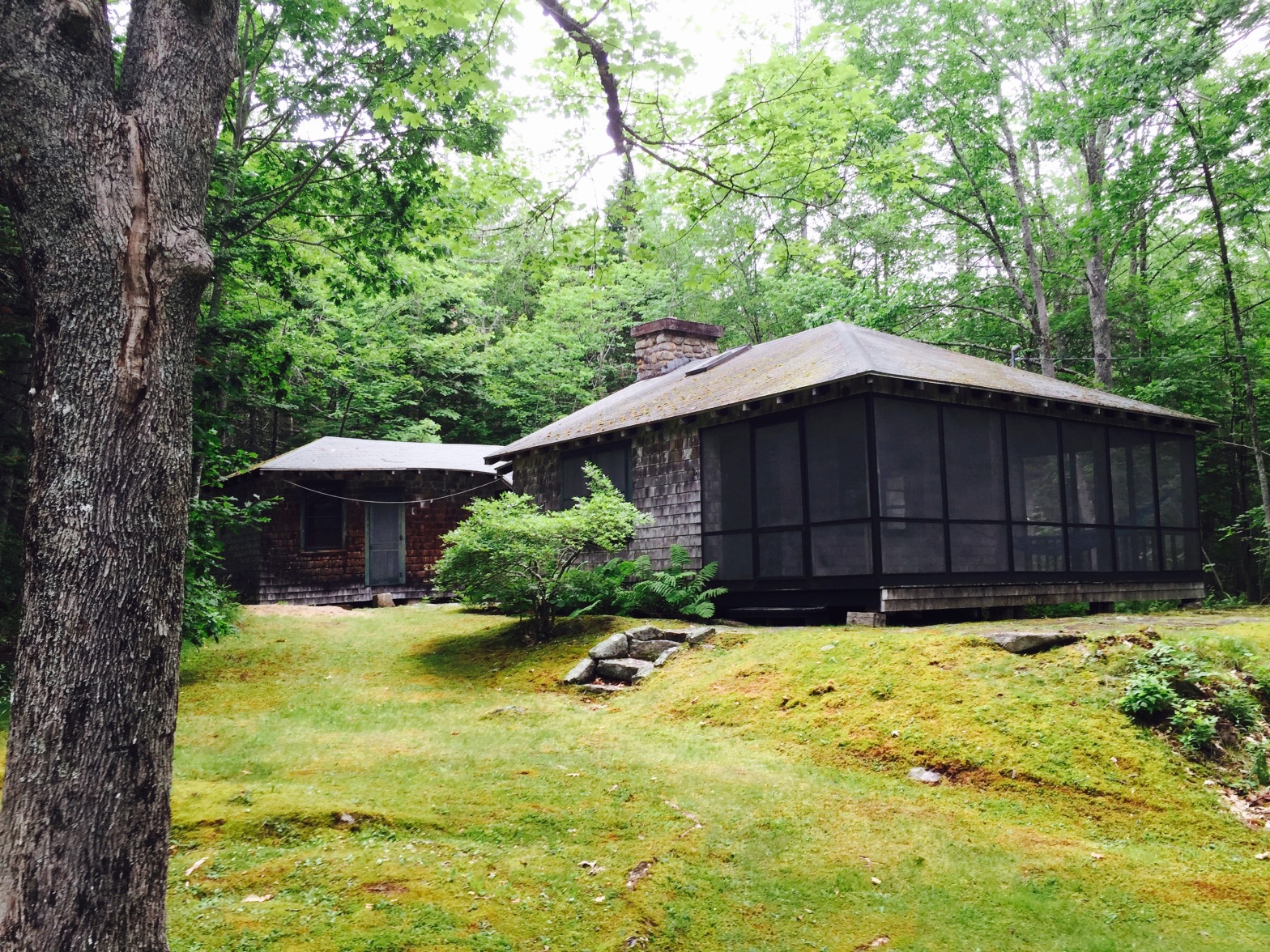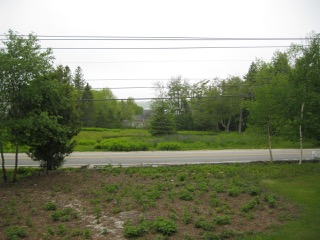
“Children and lunatics cut the Gordian knot which the poet spends his life patiently trying to untie.”
— Jean Cocteau
I got an email from my caretaker yesterday. He couldn’t figure out how to activate the electricity in the Anchorage, which I had turned off for the winter. Emera, the service provider, told me that all he needed to do was press a button underneath the meter. In the end, this turned out to be true, but it caused Dave to make several trips out to the house as we both puzzled over what it could mean — Had they activated power to the wrong house? Had they even bothered to turn on the power in the first place? Are you sure they said “a button”?
This feels like a metaphor somehow.
Restoring a historic Maine homestead is more difficult than I thought it would be.
There, I said it.
When I first walked around the place, I realized that both foundations needed work. The Anchorage needed a new roof and some paint. There was water damage on the west wall of both buildings from ridiculous gutter systems that leaked storm run off directly down the outer walls. I soon learned that no one could even locate the septic tank for the main house.
On the whole, this was not discouraging. My ex and I had basically disassembled our Austin home and put it back together. I had sanded floors and stripped acres of wallpaper on my own in various rental properties to make them more appealing. Besides, my Realtor showed me six other houses, and all of them had flaws that would require extensive remodeling. They also had impediments to water access or no way to tap into passive income once I moved up there. I didn’t want to cash out my retirement funds without having a property that paid for its own taxes and maintenance, at the very least, because then all the cash would be tied up in the house, and the only way to liquidize the equity would be to sell or refinance. I wanted a property that I could rent in the summer — and still live on. And with my budget, that meant renovation and restoration was in the cards.
The inspector’s report contained mostly good news, especially considering the age of the Anchorage. Thanks to conscientious attempts to counteract the forces of gravity, there was remarkably little structural damage. For all practical purposes, the Anchorage was move in ready.
Nevertheless, as the previous owner wryly remarked once the closing papers had been signed, the place “has a lot of moving parts.”
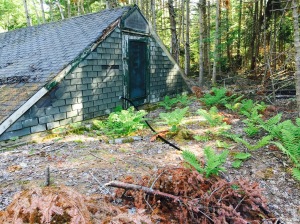 The first sign of systematic trouble came in the form of the water testing report, which showed high concentrations of arsenic and heavy metals in one spring, the one that feeds the Cabin, and lower concentrations of arsenic (but no heavy metals) in the Anchorage spring. The springs themselves are enormous; one has a cistern that is thirty feet long. Falling down “houses” in the woods cover them both, and plastic tubes run through the boggy woods to the property. These springs once fed a property up the road as well, through a system of pipes that run hundreds of feet east to what must have been a pump house.
The first sign of systematic trouble came in the form of the water testing report, which showed high concentrations of arsenic and heavy metals in one spring, the one that feeds the Cabin, and lower concentrations of arsenic (but no heavy metals) in the Anchorage spring. The springs themselves are enormous; one has a cistern that is thirty feet long. Falling down “houses” in the woods cover them both, and plastic tubes run through the boggy woods to the property. These springs once fed a property up the road as well, through a system of pipes that run hundreds of feet east to what must have been a pump house.
There is no shortage of water. It flows all the way down Caterpillar Hill, through my woods and into the marshy foot of my meadow, where it inundates my neighbor Pat’s careful landscaping in the spring. The dampness below is what’s kept the wood of both houses in pristine condition all these years.
Thus, it was a bit ironic that the well guy, a taciturn Yankee who looked for all the world like a sea captain, had to bring in special equipment to fracture the bedrock once he got down to 400 feet and still was coming up dry. That cost a pretty penny. The well, now full, sits amidst a glorious expanse of sand that Ben Webb, the excavator, trucked in to support the weight of the concrete mixer that poured the foundation last summer. I’m set to tap it this summer when the plumbers reconnect the Cabin’s plumbing. If it contains arsenic, I’m going to cry.
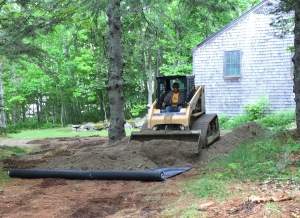
Last summer was all about the Cabin foundation. The house was sinking into a bog at the northwest corner; in another decade, the support beams would have snapped. Since this is the house I’m going to live in, I needed to act fast.
The house was in the air for almost two months, while Ben built roads and moved dirt around to create new pathways for the water to go, and the very handsome — sorry folks, no pictures of that crew — family of Joel Wilson built forms and poured the concrete in stages. Finally, it was carefully lowered back on to the new foundation with system of many hydraulic jacks jerry rigged into a control board.
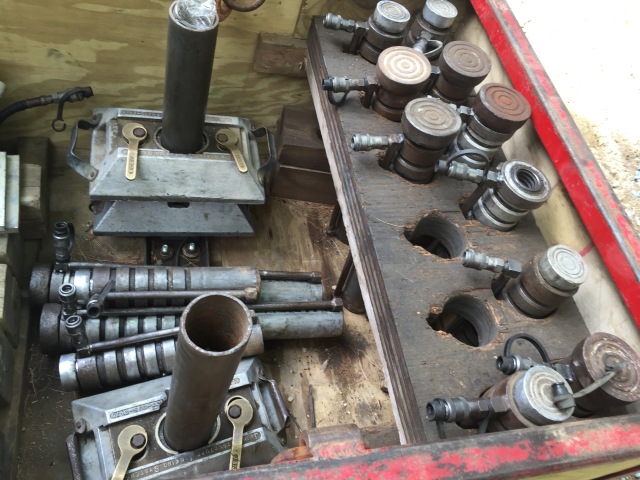
This summer is all — or mostly — about plumbing and water. Ben dug the leach field in my front yard last fall before the first frost, and sometime soon — ahem — he is going to put in the tanks and lay the connecting sewer pipes. The plumbers need to
- divert some pipes.
- install a pump beneath the foundation on the west wing to help the water flow.
- install a pump in the well itself.
- reconnect the plumbing in the Cabin.
- insulate the pipes so that I can have water year round in the Cabin.
- connect water to the Anchorage, either from its spring or from the new well.
Meanwhile, putting a solid foundation beneath the Cabin has led to problems of its own. The carpentry crew needed to cut around and stabilize what were then two Cabin chimneys in order to do the lift. Sadly, I lost the chimney in my bedroom in that maneuver; it had been poorly built and was cracked. No romantic fires in there for me. The silver lining will be a larger master bath, complete with skylight.
Creating clearance around the stone chimney and hearth in the Cabin’s great room cost thousands of dollars and has left structure damage that still needs to be repaired. Moreover, stabilizing the foundation, which settled all the windows down into their sashes for the first time in many years, has caused damage to the roof, last shingled when the house was crooked. A mason needs to come in and re-flash the chimney, and the whole building has to be re-roofed.
Move one thing, and two others break. It’s a Gordian knot, all right.
Fortunately, I am a poet.

